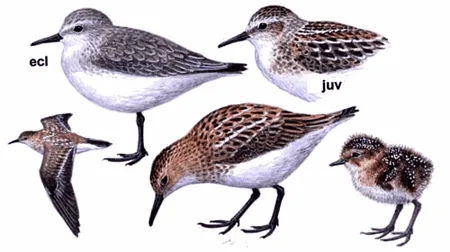
Little Stint
[order] CHARADRIIFORMES | [family] Scolopacidae | [latin] Calidris minuta | [UK] Little Stint | [FR] Becasseau minute | [DE] Zwerg-Strandlaufer | [ES] Correlimos Menudo | [NL] Kleine Strandloper
Subspecies
Monotypic species
Physical charateristics
Tiny, stint with short bill, feathers of upperparts have dark brown cintres and pale rufous fringes or tips. Mantle with yellowish edges forming distinct “V”. Head, neck and breast rufous buff with brown streaks, rest of underparts, throat and chin white.
Female averages larger. Non-breeding adult has brownish grey upperparts mottled dark and fringed pale, crown gey, streaked dark, eyestripe and sides of breast dull grey, rest of face and underparts white.
Female averages larger. Non-breeding adult has brownish grey upperparts mottled dark and fringed pale, crown gey, streaked dark, eyestripe and sides of breast dull grey, rest of face and underparts white.
Listen to the sound of Little Stint
[audio:http://www.aviflevoland.nl/sounddb/L/Little Stint.mp3]
Copyright remark: Most sounds derived from xeno-canto
| wingspan min.: | 27 | cm | wingspan max.: | 30 | cm |
| size min.: | 14 | cm | size max.: | 15 | cm |
| incubation min.: | 20 | days | incubation max.: | 21 | days |
| fledging min.: | 0 | days | fledging max.: | 21 | days |
| broods: | 1 | eggs min.: | 3 | ||
| eggs max.: | 4 |
Range
Eurasia : North
Habitat
Tundra, chiefly on dry ground, often among dwarf willows, near swampy areas or salt marshes.
On migration found at small inland waters and riverbanks, or coastal, on mudflats and seashore.
In winter quarters mainly coastal, at estuarine mudflats, enclosed lagoons, tidal creeks, also at inland fresh waters.
On migration found at small inland waters and riverbanks, or coastal, on mudflats and seashore.
In winter quarters mainly coastal, at estuarine mudflats, enclosed lagoons, tidal creeks, also at inland fresh waters.
Reproduction
Bredding in June-July. Monogamous, polygynous or polyandrous. Little or no fidelity to breeding site.
Nest on ground, exposed, but sometimes covered by vegetation, and lined with leaves and pieces of grass. 4 eggs, incubation 21 days, by both parents, but in cases of polygamy by male or female only. Polyandrous females may incubate a second clutch. Chick orange to tawny, mottled above with black bands and dense rows of white or pale down tips, white underparts. Chic care by one parent.
Nest on ground, exposed, but sometimes covered by vegetation, and lined with leaves and pieces of grass. 4 eggs, incubation 21 days, by both parents, but in cases of polygamy by male or female only. Polyandrous females may incubate a second clutch. Chick orange to tawny, mottled above with black bands and dense rows of white or pale down tips, white underparts. Chic care by one parent.
Feeding habits
Feeds by rapid pecking actions, sometimes probes. Detects prey by sight. Gregarious, in small to large flocks, sometimes up to several thousand birds, and sometimes defends feeding territory.
Conservation
This species has an extremely large range, and hence does not approach the thresholds for Vulnerable under the range size criterion (Extent of Occurrence <20,000 km2 combined with a declining or fluctuating range size, habitat extent/quality, or population size and a small number of locations or severe fragmentation). Despite the fact that the population trend appears to be decreasing, the decline is not believed to be sufficiently rapid to approach the thresholds for Vulnerable under the population trend criterion (>30% decline over ten years or three generations). The population size is extremely large, and hence does not approach the thresholds for Vulnerable under the population size criterion (<10,000 mature individuals with a continuing decline estimated to be >10% in ten years or three generations, or with a specified population structure). For these reasons the species is evaluated as Least Concern.

Migration
Migratory; in broad front across much of W Palearctic; movements S-SW in Jul-Nov, birds returning mid-May to early Jun. Juveniles probably migrate farther W than adults, due to weather displacement. Finnish and Swedish population crosses C Europe, Italy, Mediterranean, France and Tunisia; also major routes between C Mediterranean and Black Sea, and via Caspian Sea and Kazakhstan lakes to and from E & S Africa, apparently following route via Rift Valley lakes; W & C Siberian breeders presumably winter in India, passing through Kazakhstan and also N through Mongolia and Tuva. In Britain, commoner in autumn than in spring, with few birds passing winter. Small numbers may migrate along E Asian coasts, including Hong Kong and Philippines. Many immatures remain S all year. Typical migrating flocks comprise 20-30 birds.
Distribution map

